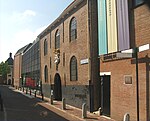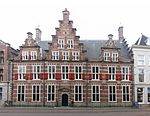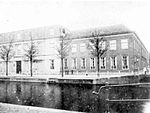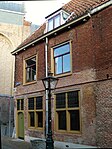Vrouwekerk

The Vrouwekerk ("Lady's Church") or Vrouwenkerk ("Ladies' Church"), originally known as the Onze-Lieve-Vrouwekerk ("Church of Our Lady"), was a 14th-Century church in the Dutch city of Leiden. In the early 17th Century, the church was attended by the Pilgrims (who left Leiden to settle in Plymouth Colony) as well as by the first colonists to settle on Manhattan.The ruined remains of this Gothic church are located on the Vrouwenkerkhof square opposite Museum Boerhaave, just north of the busy shopping street Haarlemmerstraat. The alley Vrouwenkerksteeg, which runs from the Haarlemmerstraat to the Vrouwenkerkhof, is also named after the Vrouwekerk church. The church remains have rijksmonument (national monument) status. In 2008-2009 the church underwent restoration. Carolus Clusius and Joseph Justus Scaliger were buried in the Vrouwekerk.
Excerpt from the Wikipedia article Vrouwekerk (License: CC BY-SA 3.0, Authors, Images).Vrouwekerk
Waardgracht, Leiden
Geographical coordinates (GPS) Address Nearby Places Show on map
Geographical coordinates (GPS)
| Latitude | Longitude |
|---|---|
| N 52.160833333333 ° | E 4.4897222222222 ° |
Address
Vestingwerken van Leiden
Waardgracht
2312 MV Leiden
South Holland, Netherlands
Open on Google Maps










